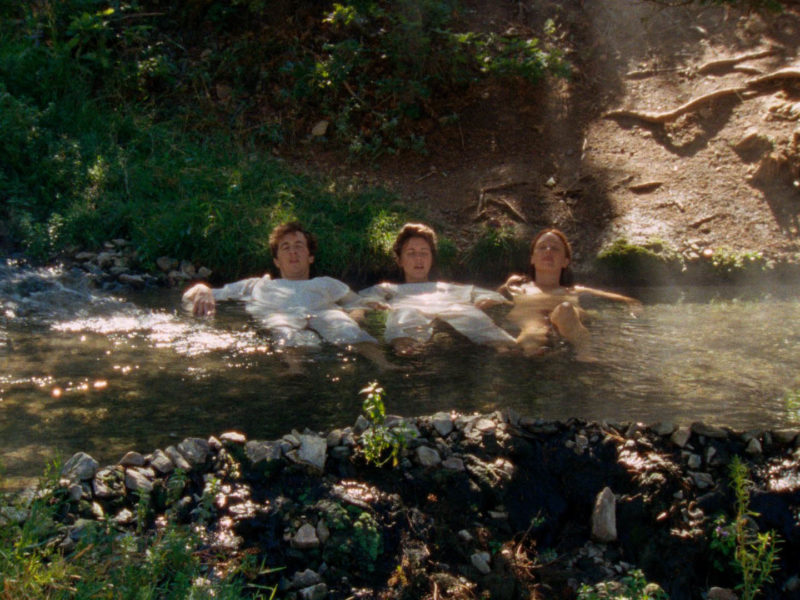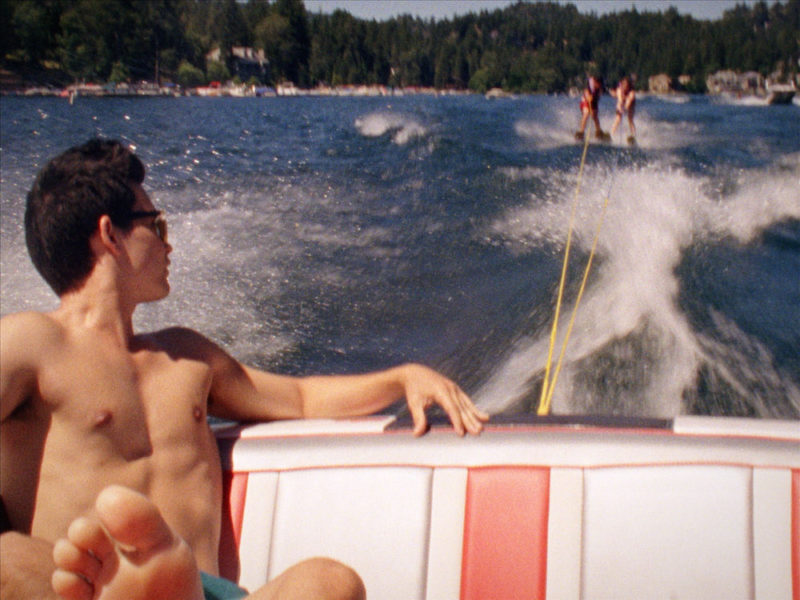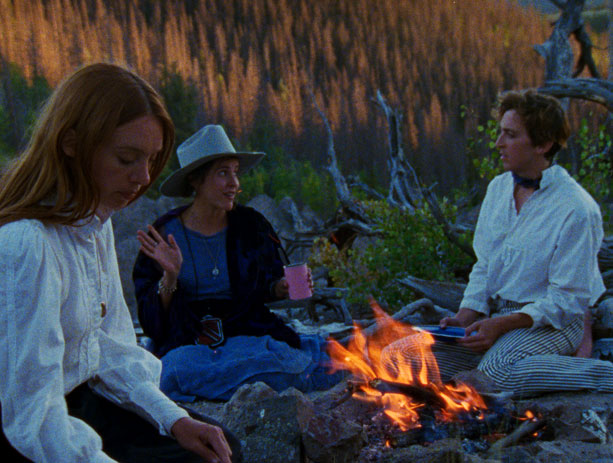Like Kalman and Horn’s Warholian proof-of-concept road-movie featurette Blondes in the Jungle (2009), Two Plains drops modern-day city-slicker types into an exotic setting rendered with the affectionate air-quotes artifice of micro-budget production design. Here, dandy illustrator Milton Tingling (filmmaker Benjamin Crotty), French geologist Ozanne Le Perrier (Laetitia Dosch), and spiritualist con-woman turned true believer Alta Mariah Sophronia (Marianna McClellan) arrive in a Colorado spa town renowned for its mineral water and hydrotherapy treatments; these lonesome cowboys soon take to the hills in search of a more “authentic” experience at unspoiled natural hot springs. Encounters ensue with cowboys, Indians, and the ghosts of an abandoned whorehouse. Forgoing sepia-tint past-tense pastiche in favor of Super 16mm richer than any filter, the film embodies a past that hardly seems stable. The tone is its most anachronistic element—the sense of humor is an alchemy of laid-back hipster-hangout banter and what Kalman describes as the “aggressive absurdism” of the David Wain school of meta-comedy, and it’s leavened with plenty of New Age philosophy as Ozanne and Alta Mariah debate on behalf of the “hard” and “soft” sciences. Alta Mariah’s belief in the mystical energies of the very rocks surrounding her is a rhyme with the film’s ravishing and plentiful nature photography, as well as Ozanne’s own more literal eye for the traces of traces of the last Ice Age. Hence, while L for Leisure was “a response to our childhood memories,” as Kalman said of the film’s inspiration when I spoke to the filmmakers over the phone last week, Two Plains & a Fancy is “a response to the landscape of Colorado.” (All this is an intriguing development of one sequence in L for Leisure, which uses as a backdrop in the Icelandic town of Laugarvatn, where a spa has been built over a natural hot spring, in a landscape bearing the visible evidence of ancient geological processes.) Horn and Kalman’s previous films as “Ball Deep International” are peopled, in front of and behind the camera, with collaborators collected on their journeys through academia and the alternative festival circuit, including their Columbia undergrad classmates in Vampire Weekend, who contributed to the music in Blondes in the Jungle, and filmmakers Crotty, Gabriel Abrantes, and Mati Diop, all of whom appear in L for Leisure. Horn and Kalman, both 35, share writing, directing, and editing duties equally, but a spokesman/silent partner dynamic emerges in their joint interviews, which reflects Horn’s contentment to play Teller to Kalman’s Penn.
Two Plains & a Fancy The film’s acknowledgement of geothermal activity, ancient volcanic eruptions and earthquakes and glaciers, makes its anachronisms seem comparatively inconsequential. In geological time, the distance from 1893 to today is an eye-blink, and so inflections like Benjamin Crotty’s 19th-century watercolorist going, “sweeeeet,” or a tourist shop selling “Local Artesian Mineral Water,” don’t feel that anachronistic. Lev Kalman: That’s what, in part, inspired the film: the fact that all of the things they would be talking about then are still visible in the landscape now. It’s not like we have to be, “Oh, imagine what these mountains were like 100 years ago.” But I would note that the artesian water was a trickier thing that we tried to do, which is find things that feel anachronistic, and present them in ways that push that, but that aren’t wrong. There were mineral water crazes even back then, and that was part of the tourism industry of Colorado. I wanted to talk about that! These are obviously 21st-century people playing dress-up, and it’s funny when Crotty is renting the horses from Michael Murphy and asks, “Do you take Amex?”—but the American Express money-order business predates the Civil War. And thematically, you’re dealing with this urban fetishization of rural authenticity, which is hardly unique to our current moment in history. LK: In that town scene, they’re wandering around and you see a store has multiple editions of The New York Times and The Washington Post—it was a time when there was already a kind of media saturation, and you had electronic communication through telegraph. A lot of the things that we think of as being modern were already in a first flourish back then. Michael Murphy wears Levi’s 501s. The overtly 19th-century-sounding character names seem designed to emphasize the setting as an idea of the past—that you, like Milton when he sketches the Native American girl, are using your “imagination [to] travel back in time” to reveal a greater truth, which may or may not actually be true. But, as the film touches on, layers of history do remain present everywhere: in a spiritual sense, maybe, if you buy into that as Alta Mariah does; and literally, in terms of place names, or the Old West movie towns still standing in Arizona. Was the Western set used at the beginning of the film something you guys built? LK: That was an Old West movie set location, and then it got repurposed, so now people stay there for an “Old West” experience. People stay with their kids, and ride horses. So it’s pretty much in the same economy that we’re talking about within the film. And what made us love that location is that it looks cheap. It looks like what we were trying to evoke, which is the sense of new money suddenly showing up in this town, and the idea that, when you would go visit a Colorado mining town in 1893, this was not something that had been there for hundreds of years—this was something brightly painted, brand-new, trying to impress you while at the same time not having much depth behind it. How much of this film was written around locations? LK: We had planned out a lot of the film for years, just as a broad outline, with the kinds of locations we’d want to have. And then I went to this small town three years ago, just visiting a friend, and was suddenly seeing all around me all of the locations we had imagined. For example, the second spa [in the film] was something we thought we were going to have to build. We sent drawings to our art director, and then Whitney’s partner was looking at our location on Google Maps— Whitney Horn: Aerial View! LK: —and he was like, wait, what’s this place? And there it was, a photo of what we had wanted. So, much of the movie was us picturing the sort of world that we needed, and that world being like, “Yeah, we’re still here.” The fact that it was an Old West movie set leads me to the observation that there’s a cinematic layer to this kind of misremembering, as well. In the séance scene, the use of double exposure reminds us that early trick photography was an important part of spiritualism. Are there other elements that consciously invoke this era of the past as it’s represented through the production of culture, as opposed to just as personal memory? LK: We tended to turn more toward 19th-century photography as a reference point rather than Westerns about that time. I also feel like the opening of the film has a real Oregon Trail computer-game vibe: the Native American girl, Michael Murphy, the woman in town—our sound designer called them all “the non-playable characters.” And the many [scenes] of long conversation was because this is a more oral culture, where they’re like, “Oh yeah, let’s just talk all night.” We tried to give space for that. Are there other filmmakers in the U.S. or abroad whose treatment of historical time and cultural memory interest you? People whose way of engaging with how things are remembered and misremembered that you think about? LK: One that comes to mind who’s contemporary is Shireen Seno. Nervous Translation is her new film, which I haven’t seen yet, but Whitney and I are both huge fans of her first feature, Big Boy. It’s her doing a memory film for a time she doesn’t actually remember. She’s a Filipino filmmaker, and it’s her re-creating what it was like for her father’s childhood, in the 1940s and ’50s. She does it like us, in terms of doing the distant past and still feeling like a contemporary film. A term that Whit and I used was “talking about the past in the present tense,” and what she does is similar. Nothing showy, like, “Wow, look at how I’ve really re-created this moment—you might think this is a movie from the 1950s.” Instead it feels very much like a film that someone is making now, but where the feeling of loss between what was then and what is now is present—the feeling of there being an effort at re-creation, and misremembering, missing it, is very much part of the experience of watching it.
L For Leisure With someone like Eugène Green and The Living World, his contemporary-dress medieval drama, it’s so non-indexical that it becomes funny. I see a little of that humor in Two Plains, in things like using smoke to represent a train off screen. There’s a certain amount of play there, but also a sincerity about willful suspension of disbelief. LK: There’s a reason the smoke in that first scene happens as the first thing in the movie. We wanted the audience to be like, “Okay, here are the parameters. It’s placed in the past, but they’re not going to make a big show of that, they’re going to evoke that with limited means.” In shooting Two Plains on Super 16mm, are there qualities of the film stock you’re using that you’re trying to push or emphasize, to manipulate or shape the photographed image? LK: Whit, I would defer to you on that, but I can start talking because I just love talking. WH: I’d prefer for you to keep talking. I think you have just as much to say about it as I would. Or more, rather. LK: I think this how our interviews usually go. This was our first film to be done in Super 16mm rather than in 16mm, and so it was our own minor version of moving to CinemaScope—a widescreen Western, to make the characters feel even more in the place. When it comes to colors, 16mm film and celluloid in general is very responsive to what you see in front of you, whereas with the digital image you often have shape it into reproducing it as it would be with the eye. That we could photograph color and make it look the way it was supposed to look was a real benefit for us—being able to actually respond to the landscape, and have that richness be there instead of being something that we had to add afterward or consciously manipulate. When I lived in Iceland, we had a geologist friend, and on road trips together we would point out rock formations to her and say, “So how did they get that way?!?” I loved the scene in the film where everyone is listening to the French geologist explain what they—and we—are seeing, and pointing at things and getting really excited. It’s a display of active gratitude and trying to inhabit the moment as fully as possible, and I found it really sweet. LK: That was one part of the film that was only broadly outlined when we got to Colorado, and then we met with a geologist and had exactly your experience. He would show us locations; he was driving with Whitney and I was driving with our producer Annalise [Lockhart], and we would be driving by rock formations and I would keep bugging him, over a walkie-talkie: “What’s that? How’d that happen?” It activates the whole space—everything has a reason behind it, it’s not just like, a hill. You can ask about anything, and someone can start giving you all this secret information about how it got that way. Our geology consultant took the whole cast on a geology tour, and we shaped the scene to match thematics of the film and whatnot, but that feeling of suddenly being present in this world, that excitement, was real. Probably one of the best days of the shoot was the geology tour day—everyone was enthralled. Are there preconceptions you’re pushing against when you’re trying to depict enjoyment and leisure cinematically? Like when Milton is having charcuterie, he says, “I feel so French”—you do say that harmless dumbass stuff when you’re conscious that you’re having a good time and want to fully acknowledge it. How do you film somebody simply having a good time, in a way that is recognizably a movie? LK: More than we are with other aspects of our films, we are pretty consciously pressing against other representations of leisure. Certain kinds of jokes might feel too satirical, in the sense of being a little on the nose about the class structure that enables this. When it comes to depictions of leisure, we have certain areas we can explore that it seems like other filmmakers don’t as much, and one is that very behavioral sort of talk that happens, to just fill up the space, and that doesn’t satisfy any narrative economy or even work as jokes. Both for this film and for L for Leisure, there’s the challenge to find a rhythm that respected the leisure, instead of just denoting it and moving on.
Two Plains & a Fancy The rhythm of the editing is such that we really do see a lot of rocks—it seems like we’re meant to decouple from the narrative from a bit. Are you conscious of requesting a different kind of headspace than most narrative films do, from your audience? LK: We are definitely conscious of that! [Laughs] And we try to guide people through it as much as we can. In all of our films, but this one especially, we try to tell the audience: it’s okay to get distracted from the characters, and start letting your eye wander to the space, to lose track of the past, and start seeing it as real rocks you can visit. The performances create a very contemporary dynamic. Milton is this fey, almost Buster Bluth type, Alta Mariah has this perfect grad-school self-absorption. Could you talk about what directions you pushed the actors into? LK: An overarching principle was that we wanted our re-creation of the past—re-creation’s not the right word, our reenactment, or whatever—to be both obviously made now, and also respectful of this not being now. So when we were giving directions to the costume designer, for example, we were like, “We want everything to be accurate, but never distractingly accurate.” And similarly when working with the actors, we tried not to throw in too many real signifiers of nowadays, but at the same time we didn’t want that to be part of the effort of the acting. A lot of it is getting them to not try to sell the material on our behalf. In rehearsals, we focused on present-ness—emphasizing that they should just be present with each other and with the surroundings. Finally, what is Michael Murphy doing in this movie? I wanted to ask you that before I finished. LK: He’s an avatar for some kind of ancestry to what we’re doing. He’s always played the urbane character in the setting where you wouldn’t expect to see one—I forget whether he’s Sears or Roebuck in McCabe & Mrs. Miller. And Altman in general was always playing with anachronism, working with styles of acting that wouldn’t be what you’d expect for the context. Mark Asch has written about movies for Reverse Shot, The Village Voice, Little White Lies, and The Reykjavík Grapevine.


